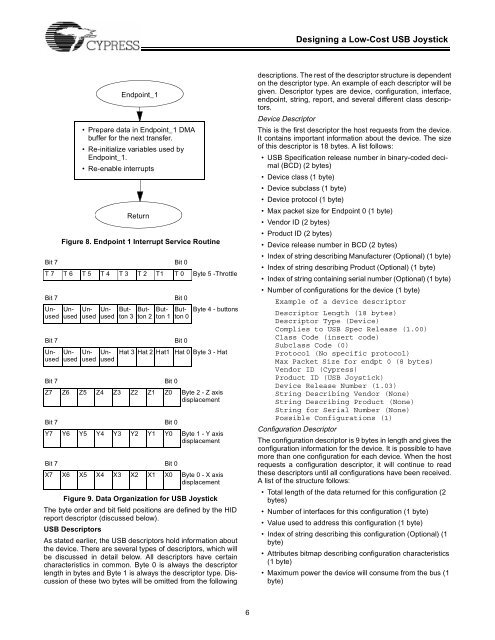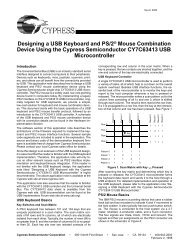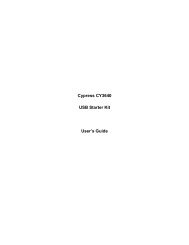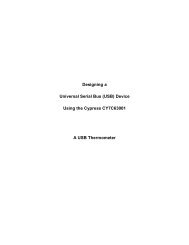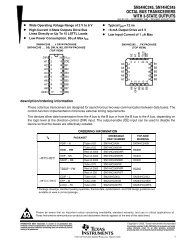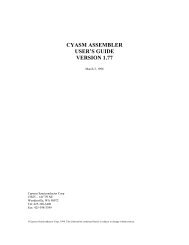Designing a Low-Cost Analog USB Joystick with the Cypress ...
Designing a Low-Cost Analog USB Joystick with the Cypress ...
Designing a Low-Cost Analog USB Joystick with the Cypress ...
You also want an ePaper? Increase the reach of your titles
YUMPU automatically turns print PDFs into web optimized ePapers that Google loves.
<strong>Designing</strong> a <strong>Low</strong>-<strong>Cost</strong> <strong>USB</strong> <strong>Joystick</strong><br />
Figure 8. Endpoint 1 Interrupt Service Routine<br />
Bit 7 Bit 0<br />
T 7 T 6 T 5 T 4 T 3 T 2 T1 T 0 Byte 5 -Throttle<br />
Bit 7 Bit 0<br />
Unused<br />
Unused<br />
Unused<br />
Unused<br />
Button<br />
3<br />
Button<br />
2<br />
Button<br />
1<br />
Button<br />
0<br />
Bit 7 Bit 0<br />
Unused<br />
Unused<br />
Unused<br />
Unused<br />
Endpoint_1<br />
• Prepare data in Endpoint_1 DMA<br />
buffer for <strong>the</strong> next transfer.<br />
• Re-initialize variables used by<br />
Endpoint_1.<br />
• Re-enable interrupts<br />
Return<br />
Hat 3 Hat 2 Hat1<br />
Bit 7 Bit 0<br />
Byte 4 - buttons<br />
Hat 0 Byte 3 - Hat<br />
Z7 Z6 Z5 Z4 Z3 Z2 Z1 Z0 Byte 2 - Z axis<br />
displacement<br />
Bit 7 Bit 0<br />
Y7 Y6 Y5 Y4 Y3 Y2 Y1 Y0 Byte 1 - Y axis<br />
displacement<br />
Bit 7 Bit 0<br />
X7 X6 X5 X4 X3 X2 X1 X0 Byte 0 - X axis<br />
displacement<br />
Figure 9. Data Organization for <strong>USB</strong> <strong>Joystick</strong><br />
The byte order and bit field positions are defined by <strong>the</strong> HID<br />
report descriptor (discussed below).<br />
<strong>USB</strong> Descriptors<br />
As stated earlier, <strong>the</strong> <strong>USB</strong> descriptors hold information about<br />
<strong>the</strong> device. There are several types of descriptors, which will<br />
be discussed in detail below. All descriptors have certain<br />
characteristics in common. Byte 0 is always <strong>the</strong> descriptor<br />
length in bytes and Byte 1 is always <strong>the</strong> descriptor type. Discussion<br />
of <strong>the</strong>se two bytes will be omitted from <strong>the</strong> following<br />
descriptions. The rest of <strong>the</strong> descriptor structure is dependent<br />
on <strong>the</strong> descriptor type. An example of each descriptor will be<br />
given. Descriptor types are device, configuration, interface,<br />
endpoint, string, report, and several different class descriptors.<br />
Device Descriptor<br />
This is <strong>the</strong> first descriptor <strong>the</strong> host requests from <strong>the</strong> device.<br />
It contains important information about <strong>the</strong> device. The size<br />
of this descriptor is 18 bytes. A list follows:<br />
• <strong>USB</strong> Specification release number in binary-coded decimal<br />
(BCD) (2 bytes)<br />
• Device class (1 byte)<br />
• Device subclass (1 byte)<br />
• Device protocol (1 byte)<br />
• Max packet size for Endpoint 0 (1 byte)<br />
• Vendor ID (2 bytes)<br />
• Product ID (2 bytes)<br />
• Device release number in BCD (2 bytes)<br />
• Index of string describing Manufacturer (Optional) (1 byte)<br />
• Index of string describing Product (Optional) (1 byte)<br />
• Index of string containing serial number (Optional) (1 byte)<br />
• Number of configurations for <strong>the</strong> device (1 byte)<br />
Example of a device descriptor<br />
Descriptor Length (18 bytes)<br />
Descriptor Type (Device)<br />
Complies to <strong>USB</strong> Spec Release (1.00)<br />
Class Code (insert code)<br />
Subclass Code (0)<br />
Protocol (No specific protocol)<br />
Max Packet Size for endpt 0 (8 bytes)<br />
Vendor ID (<strong>Cypress</strong>)<br />
Product ID (<strong>USB</strong> <strong>Joystick</strong>)<br />
Device Release Number (1.03)<br />
String Describing Vendor (None)<br />
String Describing Product (None)<br />
String for Serial Number (None)<br />
Possible Configurations (1)<br />
Configuration Descriptor<br />
The configuration descriptor is 9 bytes in length and gives <strong>the</strong><br />
configuration information for <strong>the</strong> device. It is possible to have<br />
more than one configuration for each device. When <strong>the</strong> host<br />
requests a configuration descriptor, it will continue to read<br />
<strong>the</strong>se descriptors until all configurations have been received.<br />
A list of <strong>the</strong> structure follows:<br />
• Total length of <strong>the</strong> data returned for this configuration (2<br />
bytes)<br />
• Number of interfaces for this configuration (1 byte)<br />
• Value used to address this configuration (1 byte)<br />
• Index of string describing this configuration (Optional) (1<br />
byte)<br />
• Attributes bitmap describing configuration characteristics<br />
(1 byte)<br />
• Maximum power <strong>the</strong> device will consume from <strong>the</strong> bus (1<br />
byte)<br />
6


